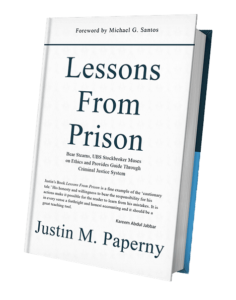Introduction
A significant aspect of our work at Prison Professors is to help people understand the criminal justice system in the United States.
As part of that mission, we seek to help people facing the criminal sentencing process understand how to mitigate the consequences of their convictions and obtain better sentencing outcomes.
This blog is the first in a series to help people understand how best to present themselves to a federal judge for sentencing.
Discussion
Although several programs now provide people more opportunities to reduce their federal prison term after sentencing, there is no better outcome than to obtain the lowest possible sentence from the sentencing judge.
Programs for early release under the First Step Act of 2018, which have been getting headlines recently, are a huge step toward reducing lengthy prison terms and mass incarceration in America.
Indeed, the First Step Act rollout is currently ongoing, and thousands of people have been released from federal prisons in recent weeks. The First Step Act is finally bearing fruit and increasing the chances that federal prisoners can return to their communities earlier. See below:
But people facing federal sentencing cannot lose focus of the sentencing mitigation opportunities available before the sentencing court. Those opportunities often represent the best possible chance to mitigate a possible prison sentence.
The Federal Sentencing Guidelines
To understand sentencing mitigation, it is vital to appreciate the US Sentencing Guidelines (or USSG) role in the federal sentencing process.
Significantly, in the federal system, the sentencing guidelines are purely advisory, not mandatory. To take them as mandatory violates a person’s constitutional rights.
Thus, a person’s criminal sentence (and possible prison time) begins with the US Sentencing Guidelines, but it does not end there. The guidelines provide a baseline for the sentencing judge, but they are not mandatory.
What are the US Sentencing Guidelines?
Federal judges consult the Sentencing Guidelines as a starting point to determine a fair and consistent sentencing range in a case. The Sentencing Guidelines consider the seriousness of the criminal conduct and the defendant’s criminal record.
In essence, the sentencing guidelines result from the interplay of a person’s prior criminal history and their current offense. As such, repeat offenders or career criminals have a prior criminal history and are treated more severely by the sentencing guidelines.
Based on the nature and specific characteristics of the offense, the sentencing guidelines offer a sentencing range for the judge to consider – a higher range for more severe offenses and a lower range for less severe situations.
For example, the sentencing guidelines will recommend a more severe sentence in fraud cases where the fraud resulted in a significant monetary loss or involved many victims. Or, when a person occupied a position of trust or played a leadership role, the guidelines will offer higher possible sentencing enhancements for the judge to consider.
Alternatively, the sentencing guidelines offer a lower range when a person played a minor role in the offense, cooperated, accepted responsibility, or presented other factors to support a lower sentence.
Because federal criminal prosecutions often involve multiple people in the roles of co-defendants or co-conspirators, sentencing judges often have the chance to grant a downward departure for minor players.
Pro-Tip: While legally, all participants to a criminal enterprise should be equally guilty, principles of fairness and equity allow a judge to accommodate the circumstances of minor players under the guidelines.
For a detailed discussion of how Elizabeth Holmes’ sentence will get calculated under the USSG See below:
- Calculating Holmes’ Prison Sentence- Part 1
- How Can ELIZABETH HOLMES Get a Shorter FEDERAL PRISON Term?
How Far Will A Sentencing Judge Depart?
Acknowledging that the guidelines are advisory is not to say that federal sentencing judges ignore them altogether or routinely deviate from them.
To be sure, they definitely use them as a starting point, and for a good reason. Moreover, reports indicate that federal sentencing judges tend to follow the recommended sentencing guidelines calculations more often than not.
Moreover, they have no reason to ignore wholesale the work that underlies the sentencing guidelines methodology. Indeed, judges using them as a starting point gives the sentencing process much-needed transparency and accountability.
Congress created the US Sentencing Commission in 1984 with the critical goal of reducing sentencing disparities and promoting transparency and proportionality in sentencing. The US Sentencing Commission is a bipartisan, independent agency located in the judicial branch of government. The Commission developed the US Sentencing Guidelines in the 1980s to standardize sentencing in federal cases.
While we now acknowledge that the Sentencing Guidelines only provide a recommended or advisory sentencing range, that was not always the case.
For years, federal sentencing judges believed they were duty-bound to impose no less than the sentencing outcome dictated by the guidelines. A Supreme Court case from 2005 — US v. Booker — changed that. The Supreme Court determined that the federal sentencing guidelines cannot be mandatory but rather can only be advisory.
In Booker, the Supreme Court ruled that Congress oversteps its legislative role when Congress mandates sentencing and takes over the judiciary’s role. For that reason, mandatory sentencing guidelines are unconstitutional. It is up to the judicial branch of government to dole out sentencing. Therefore, the sentencing guidelines are not binding on sentencing judges, who must retain their independence and discretion to decide sentencing matters.
Pro-Tip: People facing federal sentencing and learning what is their “guidelines range” should not give up. Remember that their sentencing judge is free to sentence outside the sentencing guidelines range.
In short, sentencing judges:
- start with the guidelines calculation,
- statistically tend to stay within the guidelines range often and tend to consider the guidelines reasonable on their face,
- but can depart from the range for legally valid considerations.
Whether or not the sentencing judge chooses to depart downward or upward is up to them.
The Sentencing Judge’s Discretion
As noted, federal judges have broad discretion when sentencing people convicted of a crime. While some mandatory minimums still play a role in certain types of cases, federal sentencing judges who believe a person is deserving of a downward departure have the tools at their disposal to achieve it.
What is a downward departure for sentencing purposes?
A downward departure occurs when the federal judge imposes a sentence that is lower than the minimum sentence range suggested by the sentencing guidelines.
What is an upward departure for sentencing purposes?
An upward departure occurs when the federal judge imposes a sentence that is higher than the maximum sentence range suggested by the sentencing guidelines.
In addition to the recommended sentencing guidelines calculation, sentencing judges control all other aspects of sentencing.
For example, it is up to the sentencing judge whether a person should be allowed to self-surrender later or whether they are remanded to the custody of the federal Bureau of Prisons immediately. This issue may appear trivial to others, but it can have profound consequences to the defendant.
Let’s not forget that criminal sentences can consist of a mix of incarceration (mostly in prison, but also house arrest or home confinement, etc.), a term of supervised release after incarceration, forfeiture, fines, restitution, or community service.
Pro-Tip: In federal cases, there is a $100 “special assessment” for each felony count on which a person has been found guilty, whether by guilty plea or at trial.
By having control over all the levers that affect a person’s overall sentence, federal judges are in the best position to determine what is fair overall for each individual criminal defendant.
How do judges decide sentences?
Federal judges consider several factors when deciding on an appropriate criminal sentence, including the sentencing guidelines. All told, judges consider past criminal record, age, education, the circumstances of the offense, the defendant’s role, and other individual factors.
A federal sentencing judge’s goal when determining a person’s overall sentence is to impose an overall sentence that is sufficient, but not greater than necessary, to:
- provide just punishment for the offense;
- reflect the seriousness of the offense;
- promote respect for the law;
- promote deterrence of criminal conduct;
- protect the public from the risk a person will commit additional crimes; and
- provide the defendant with needed educational or vocational training and medical care.
In essence, sentencing is a balancing act.
And while incarceration is most top of mind for criminal defendants and their loved ones, overall sentencing outcomes also matter significantly. Specifically, the overall sentencing outcome includes how many years of supervised release the judge imposes and how much are the fines and restitution. Those factors will also affect a person’s future and their ability to bounce back after the journey through the criminal justice system ends.
Cooperation or Substantial Assistance As a Basis for Downward Departure
Cooperation or “substantial assistance” is a factor that can heavily affect a sentencing judge’s decision to order a sentence more lenient than that recommended by the guidelines. Judges are often former prosecutors. As such, they have a particular appreciation for assistance with a criminal investigation.
Cooperation or “substantial assistance” is a common reason for a downward departure in federal sentencing. When there is cooperation, prosecutors can make the motion for downward departure based on cooperation, describing the value of a person’s cooperation to the court.
But, when prosecutors fail to make a motion for a downward departure based on substantial assistance or cooperation, a defendant can also share about their cooperation activities with the judge. As always, the sentencing judge has the discretion to weigh this factor in favor of departure or not.
Additional Reasons for Downward Departure
In addition to cooperation matters, a federal sentencing judge may also grant a downward departure where the judge finds that the defendant:
- the defendant came forward voluntarily to disclose criminal conduct;
- the defendant was forthcoming about their own role in the crime;
- the defendant quickly accepted responsibility;
- the defendant has mental health or substance abuse issues;
- the defendant was subjected to legal duress;
- the defendant was subject to coercion or undue influence (e.g., Elizabeth Holmes’ Svengali defense);
- the defendant’s compelling personal life story warrants departure;
- the defendant has a measurable history of community service;
- the defendant has made efforts to make amends with society and victims;
- the defendant has made restitution payments for the victims;
- the defendant is unlikely to re-offend;
- the totality of the circumstances supports a lower sentence.
This is not intended as an exhaustive list.
Undoubtedly, there is a lot of information a judge can consider if the defendant brings it forward to the court.
CONCLUSION
Federal criminal sentencing is a balancing act in the hands of a sentencing judge, who will consider many factors about the case and the defendant in addition to the baseline recommendations offered by the sentencing guidelines.
It is crucial for people facing sentencing to understand that the sentencing judge can consider so many other factors beyond the guidelines. But if the defendant does not present additional information, it will hamper the court’s ability to consider the totality of the circumstances.
Sentencing judges have a tremendous responsibility for a person’s liberty and future in their hands. Information pertinent to their evaluation of the person before them can help the judge decide what is a fair and equitable outcome.




